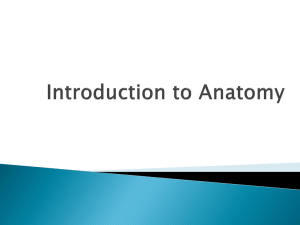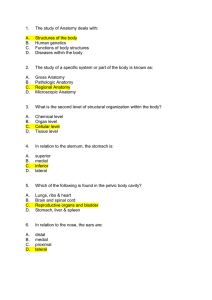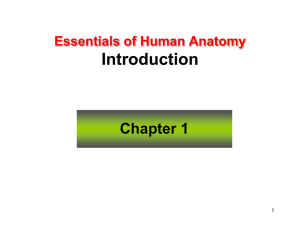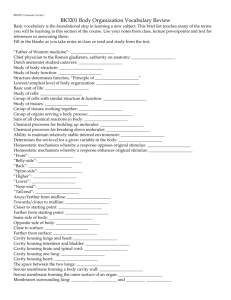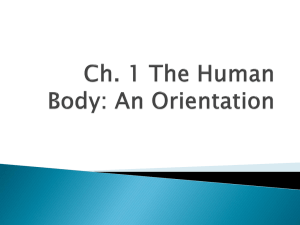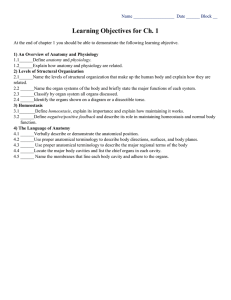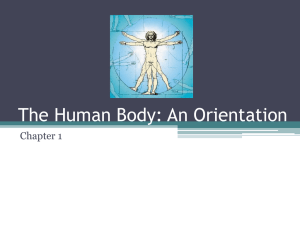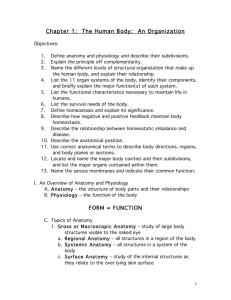Essentials of Human Anatomy 1
advertisement
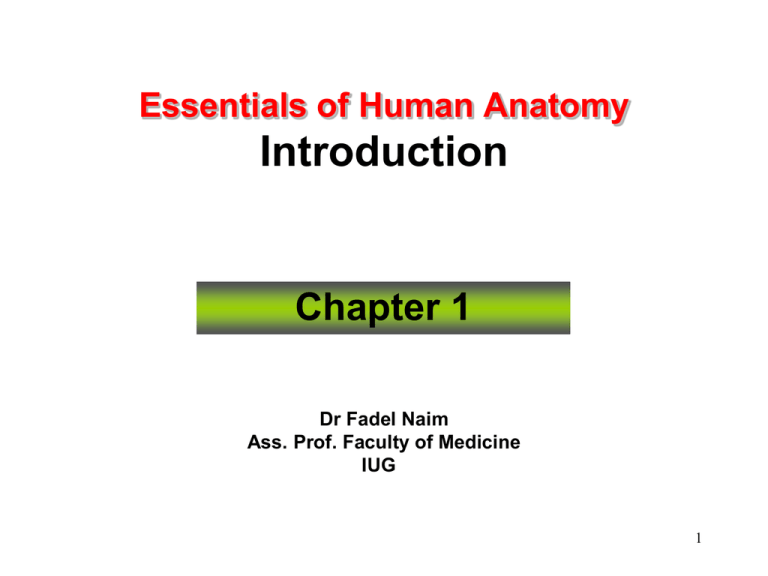
Essentials of Human Anatomy Introduction Chapter 1 Dr Fadel Naim Ass. Prof. Faculty of Medicine IUG 1 THE DEFINITION OF ANATOMY • Anatomy – Greek=to cut up, or dissect – The science that deals with the structure of the body • Kinds: – – – – Gross Anatomy Microscopic Anatomy Developmental Anatomy Comparative Anatomy Gross Anatomy • Definition: – That which can be seen with the naked eye • Kinds: – Regional: • body studied by area – Systematic: • body studied by system Microscopic Anatomy • Definition: – That which can be seen with the assisted eye • Kinds: – Cytology: • The study of cells – Histology: • The study of tissues – Organology: • The study of organs Developmental Anatomy • Definition: – The study of anatomical changes in a life cycle • Kinds: – Embryology: • The study of prenatal development – Postnatal development: • The study of structures after birth Comparative Anatomy • Definition: – Comparison of structures between organisms • Kinds: – Vertebrate: • Comparison of structures among the vertebrate classes Physiology The scientific discipline that studies the function of body structures. Structure and function cannot be completely separated. Form is related to function Levels of Organization STRUCTURAL LEVELS OF ORGANIZATION: A. The atom [i.e. Carbon (C), Hydrogen (H), or Oxygen(O)] is the least complex level. An atom is defined as the smallest particle of an element. Atoms combine with (react with) other atoms to form… B. molecules [i.e. carbon dioxide (CO2), water (H20)]. A molecule is defined as a particle composed of 2 or more joined atoms. Molecules combine with other molecules to form… C. macromolecules (i.e. carbohydrates, lipids, proteins, nucleic acids). A macromolecule is defined as a large molecule. Macromolecules combine with other macromolecules to form… D. organelles (i.e. cell membrane, nucleus, ribosomes). An organelle is defined as a small organ of a cell, which performs a particular function. Organelles collectively compose ... Levels of Organization E. cells The cell is defined as the basic unit of structure and function of living organisms! Each cell has a set of organelles and performs a particular function (i.e. a red blood cell has a biconcave shape and is a nucleate. This structure increases its surface area, allowing for the transport of more oxygen0. Some cells have all of the machinery that they need to live. Similar cells are arranged into... F. tissues (i.e. epithelia, connective, muscle, nervous). A tissue is defined as a group of similar cells that performs a specialized function. Two or more tissues combine to form... Levels of Organization G. organs (i.e. skin, heart, brain). An organ is defined as a structure consisting of a group of tissues that performs a specialized function. Two or more organs combine to form... H. organ systems (i.e. integumentary, cardiovascular). An organ system is defined as a group of organs that act together to carry on a specialized function. There are 11 organ systems. The eleven organ systems collectively form the... I. human organism An organism is the most complex level of organization and is defined as an individual living thing. J. The levels of hierarchy could be further extended to include; populations, communities, ecosystems, and the biosphere. Integumentary System • Components – Skin – Hair, nails • Function – External covering – Protection – Synthesis of Vitamin D – Location of Sense receptors Skeletal System • Components – Bones – Joints and adjacent cartilages • Function – – – – Support Protection Movement Blood cell production (red bone marrow) – Mineral storage (calcium and phosphorus) Muscular System • Components – Skeletal Muscles – Associated Connective Tissues (tendons) • Function – Locomotion – Manipulation of the environment – Facial expression (communication) – Maintain posture – Produce heat Circulatory System • Components – Cardiovascular System – Lymphatic System • Function – Transportation of materials Within the body – To and from internal and external environments Cardiovascular System • Components – Heart – Vessels • Function – Transportation of blood – Blood contains O2 and CO2, nutrients, wastes, etc. – Blood composed of plasma and cells Lymphatic System • Components – Lymphatic Organs (spleen, lymph nodes, thymus, etc.) – Lymphatic Vessels • Function – Transportation of lymph – Lymph is derived from tissue fluid – Houses white blood cells Immune System • Components – Immune Organs (red bone marrow, thymus, etc.) – White blood cells (lymphocytes, macrophages, etc.) • Function – Defense (Immune response) Nervous System • Components – Brain, Spinal cord (CNS) – Nerves (PNS), sense receptors • Function – Control system (fast, “hard wired”) – Response to external and internal environments Endocrine System • Components – Glands that secrete hormones – E.g.:Pituitary, pancreas, thyroid • Function – Control system (slow, “chemical”) – Regulates processes such as growth, reproduction and nutrient use Respiratory System • Components – Lungs – Tubing ( trachea, bronchus, etc.) – Larynx (vocal cords) • Function – Exchange of respiratory gases (O2 and CO2) between blood and atmosphere – Voice production Digestive System • Components – Alimentary canal (mouth, pharynx, esophagus, stomach, small intestine, large intestine) – Accessory structures(liver, salivary glands, etc.) • Function – Break down food into small, absorbable pieces – Between blood and lumen – Eliminate waste Urinary System • Components – Kidneys, Ureters, Urinary bladder, Urethra • Function – Eliminate waste (nitrogen) from blood – Between blood and external environment – Regulates water, electrolytes, acid/base Reproductive System • Components – Male Reproductive System – Female Reproductive System • Function – Perpetuation of the species – Hormones influence structure and function – Sexually bimorphic species Anatomical Terminology Anatomic position is a specific body position in which an individual stands upright with the feet parallel and flat on the floor. The head is level, and the eyes look forward toward the observer. The arms are at either side of the body with the palms facing forward and the thumbs pointing away from the body. Anatomical Terminology A plane is an imaginary surface that slices the body into specific sections. The three major anatomic planes of reference are the coronal, transverse, and sagittal planes. Sections and Planes A coronal plane, also called a frontal plane, is a vertical plane that divides the body into anterior (front) and posterior (back) parts. Sections and Planes A transverse plane, also called a crosssectional plane or horizontal plane, cuts perpendicularly along the long axis of the body or organ separating it into both superior (upper) and inferior (lower) parts. Sections and Planes A sagittal plane or median plane, extends through the body or organ vertically and divides the structure into right and left halves. Sections and Planes A sagittal plane in the body midline is a midsagittal plane. A plane that is parallel to the midsagittal plane, but either to the left or the right of it, is termed a parasagittal (or sagittal) plane. A minor plane, called the oblique plane, passes through the specimen at an angle. Directional Terms of the Body Directional terms are precise and brief, and for most of them there is a correlative term that means just the opposite. Relative and Directional Terms of the Body Relative to front (belly side) or back (back side) of the body : Anterior = In front of; toward the front surface Posterior = In back of; toward the back surface Dorsal =At the back side of the human body Ventral = At the belly side of the human body Relative and Directional Terms of the Body Relative to the head or tail of the body: Superior = Toward the head or above Inferior = Toward feet not head Caudal = At the rear or tail end Cranial = At the head end Relative and Directional Terms of the Body Relative to the midline or center of the body: Medial = Toward the midline of the body Lateral = Away from the midline of the body Deep = On the inside, underneath another structure Superficial = On the outside Relative and Directional Terms of the Body Relative to point of attachment of the appendage: Proximal = Closest to point of attachment to trunk Distal = Furthest from point of attachment to trunk cephalic=head frontal=forehead nasal=nose orbital=eye buccal=cheek oral=mouth cervical=neck mental=chin acromial=shoulder sternal=breast bone axillary=armpit thoracic=chest mammary=breast brachial=arm antecubital=front elbow olecranal=back elbow antebrachial=forea rm popliteal=posterior knee sural=calf carpal=wrist palmar=palm pollex=thumb digital=fingers/toes pubic=genital patellar=anterior knee crural=leg tarsal=ankle hallux=big toe occipital=base of skull vertebral=spinal scapular=shoulder blade dorsum=back lumbar=loin sacral=between hips perineal=between anus and genitalia femoral=thigh calcaneal=heel plantar=sole ORGANIZATION OF THE HUMAN BODY HUMAN BODY AXIAL PORTION APPENDICULAR PORTION head arms neck legs trunk Axial Portion DORSAL CAVITY VENTRAL CAVITY CRANIAL CAVITY brain THORACIC CAVITY lungs mediastinum thymus heart esophagus trachea VERTEBRAL CANAL spinal cord ABDOMINOPELVIC CAVITY ABDOMINAL CAVITY stomach liver spleen gallbladder small intestine large intestine PELVIC CAVITY urinarybladder internal reproductive organs Note that the diaphragm muscle separates the thoracic from abdominopelvic cavities. Note that the kidneys, adrenal glands, pancreas, and ureters are behind the abdominopelvic cavity. This is referred to as RETROPERITONEAL. Thoracic and Abdominopelvic Membranes Membrane : a soft, thin, pliable layer of tissue that either: covers a vital (visceral organ) = VISCERAL MEMBRANE lines a body cavity = PARIETAL MEMBRANE • There is a space between a visceral and parietal membrane into which SEROUS fluid is secreted for lubrication. • There are specific names for the membranes around the heart, lungs, and abdominal organs: • Serous Membranes of the LUNGS: • The membrane on the surface of the lung is called • visceral pleura. • The membrane that lines the cavity in which the lungs are located is called • parietal pleura. • The space between these two membranes is called • pleural cavity • it is filled with serous fluid. Serous Membranes of the HEART: • The membrane on the surface of the heart is called • visceral pericardium. • The membrane that lines the cavity in which the heart is located is called • parietal pericardium. • The space between these two membranes is called • pericardial cavity • it is filled with serous fluid. Serous Membranes of the ABDOMINAL ORGANS: The membrane on the surface of the liver, stomach, etc. is called visceral peritoneum. - The membrane that lines the abdominal cavity is called parietal peritoneum. - The space between these two membranes is called the peritoneal cavity, and it is filled with serous fluid. Organization of the Body Organization of the Body Abdominal Divisions • Quadrants: 4 – Right Upper Quadrant – Right Lower Quadrant – Left Upper Quadrant – Left Lower Quadrant Abdominal Divisions • Regions: 9 – – – – – – – – – Rt Hypochondriac region Rt Lumbar region Rt Iliac (Inguinal) region Epigastric region Umbilical region Hypogastric (Pubic) region Lt Hypochondriac region Lt Lumbar region Lt Iliac (Inguinal) region THE END

